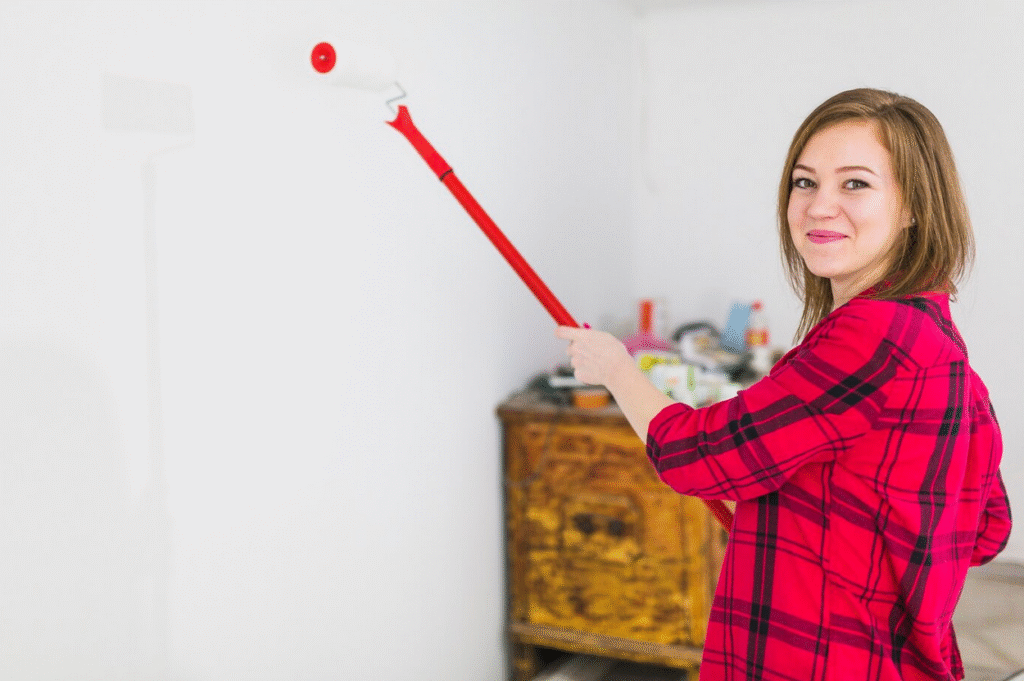Modern interiors are built around natural light. Whether you’re redesigning your living room or opening up a hallway, the right paint color can make a dramatic difference in how bright and spacious a room feels.
Choosing light colored walls that bounce light around the room isn’t just about aesthetics; it’s about function and energy. It makes a space feel fresher, cleaner, and far more welcoming.
With terms like “maximize natural light” and “reflected light” now trending in search results, it’s clear that more homeowners are looking for ways to use paint to amplify daylight.
Here’s a curated, practical guide to help you do just that, featuring real design insights, useful paint strategies, and some subtle tricks to bring more sunlight into your space.
Start With How Paint Interacts With Light
Before you jump into swatches, understand the basics of how wall colors respond to natural sunlight.
- Light Reflectance Value (LRV): A scale from 0 (black) to 100 (white), this tells you how much light a color reflects. The higher the LRV, the more the paint will bounce light.
- Finish Types Matter: A matte finish absorbs light; satin and eggshell finishes reflect more. Glossy finishes do an even better job, but use them sparingly unless you want a mirrored effect.
- Sun Orientation Counts: North-facing rooms get cool, indirect light. Choose warm undertones to balance this. South-facing rooms receive warm daylight all day and can handle cooler hues.
Once you grasp how walls behave under natural light, choosing your palette becomes much more intuitive.
The Power Of The Right White
Not all whites are bright.
A sterile white may reflect light well, but it can feel stark and lifeless. On the flip side, warm whites, think ivory, soft cream, or linen, give you similar reflectivity but with a cozier, more natural feel.
Brands like Benjamin Moore offer a wide range of white tones with subtle undertones that can shift the mood of your space depending on the time of day.
A popular choice for living rooms, soft whites with warm undertones can brighten spaces without making them feel clinical.
And if you’re working with an awkward layout or need to open up a long hallway, pairing white walls with minimalist accents and smart décor choices, like those in this guide on How To Decorate A Long Wall, can help light travel more freely throughout the space.
Pro tip: Try painting the ceiling and trim the same shade of white (or slightly lighter). This reduces visual interruption and helps natural light glide across the room.
Pale Neutrals That Still Reflect Light

If stark white isn’t your thing, pale neutrals, like soft taupe, beige, or mushroom, offer a great middle ground. They’re warm enough to create depth, but light enough to bounce sunlight naturally.
- Greige (grey + beige): One of the most searched terms on keyword tools in interior design. It adapts well to both warm and cool light.
- Soft beige and oat shades: Perfect for boho or transitional spaces. They enhance brightness while adding earthy character.
- Muted mushroom tones: Slightly darker but still reflective when paired with sheer window treatments and natural flooring.
Neutral walls are also ideal if you plan on using bolder art or furniture as focal points. They don’t compete for attention, they simply let the light do the talking.
Color With Character: Muted Pastels
There are several paint colors that go perfectly for maximum natural light, but you can never go wrong with muted pastels. They are budget-friendly and light.
Unlike deep or dark colors that absorb light, shades like blush pink, powder blue, and sage green offer just enough pigment to feel fresh without stealing brightness from your space.
- Sage Green: A current darling of search engines for eco-chic designs. When used in a room with plenty of windows, it simulates an indoor-outdoor vibe that feels alive.
- Powder Blue: Reflects light with a cool, calming tone, ideal for creative spaces or airy bedrooms.
- Blush Pink: Surprisingly versatile, it softens a room and warms the reflected light, creating a rosy glow at sunset.
Pair these colors with neutral floors, white trim, and natural fiber rugs for a look that balances playfulness with sophistication.
Gloss, Sheen, And Subtle Shine
The finish of your paint plays just as big a role as the color itself. If you’re working with a room that lacks strong daylight, introducing a semi-gloss or pearl finish on one feature wall can make a noticeable difference.
- Glossy Accent Walls: Painted opposite a window, a glossy wall acts like a soft mirror that captures and re-distributes natural sunlight.
- Pearl and metallic finishes: Subtle, elegant, and excellent for highlighting architectural details. Ideal for formal dining rooms or powder rooms.
- Avoid Overdoing It: Too much sheen can create glare. Use it only on the walls that get direct light for best effect.
Paint brands like Benjamin Moore offer designer-quality sheens that look rich but not overpowering. Just be sure your wall surface is smooth; glossy finishes will highlight imperfections.
Ceilings, Trims, And Transitions
Ceilings are often called the “fifth wall,” but they’re rarely used to their full potential. Painting them even slightly lighter than the walls creates the illusion of height and adds to the overall luminosity.
- Monochrome Trim: Painting trims and walls the same or similar shade eliminates harsh transitions and allows light to move fluidly.
- Contrast Only When Intentional: If you do go darker on trims or floors, make sure they serve a purpose, like grounding a bright, open space or framing windows for contrast.
These techniques are staples in designing cohesive interiors. For a room that flows as beautifully as it shines, take a look at How To Design Seamless Interiors to align your light-enhancing strategies with spatial harmony.
Two-Tone Walls For Visual Depth
A clever way to use paint for both light and style is through two-tone walls. Painting the upper half of the wall a lighter color and the lower half a deeper tone adds contrast and enhances brightness without sacrificing character.
- Light Over Dark: Keeps the eye upward and lets light float across the top half of the room.
- Horizontal Lines Elongate: Especially helpful in rooms with low ceilings or narrow layouts.
- Pairs Perfectly With Wainscoting or Half Paneling: Paint the top half a soft white or neutral, and the bottom half a calming color for instant architectural interest.
This approach works particularly well in dining rooms or entryways where you want a bit of structure without heavy visual weight.
What To Avoid: Light Killers

Now, a quick note on what not to do. These common mistakes can work against your goal of a bright and airy interior:
- Dark Colors on Large Walls: Shades like navy, deep green, and charcoal suck up sunlight. Unless your room is drenched in windows, avoid them as primary wall colors.
- Cool Grays Without Warmth: Trendy in older designs, these now often read as cold and lifeless in natural daylight.
- Heavy Window Treatments: Thick curtains or dark blinds can block the very light you’re trying to reflect. Opt for sheer fabrics or light-colored Roman shades instead.
- High Gloss on Flawed Walls: While gloss finishes bounce light, they’ll also spotlight every dent, nail pop, or patch job.
Choosing color is as much about avoiding the wrong direction as it is about picking the right one.
Final Thoughts
The next time you open a keyword tool or browse search results for “how to make a room feel brighter,” remember, paint is one of the simplest, most cost-effective tools at your disposal.
From light colored walls that catch the morning sun to subtle sheens that magnify the afternoon glow, every paint choice can shape your space.
To truly enhance natural light, think holistically. Consider how your window treatments, ceiling color, and even trim details affect the flow of daylight.
Let light guide your design choices, not just because it’s trendy, but because it makes rooms feel better to live in.
Whether you lean toward the soft glow of a warm neutral, the calm of sage green, or the bold reflection of a glossy accent wall, choose intentionally. And remember, sunlight is free, but how you harness it through color? That’s where the real design magic lives.


